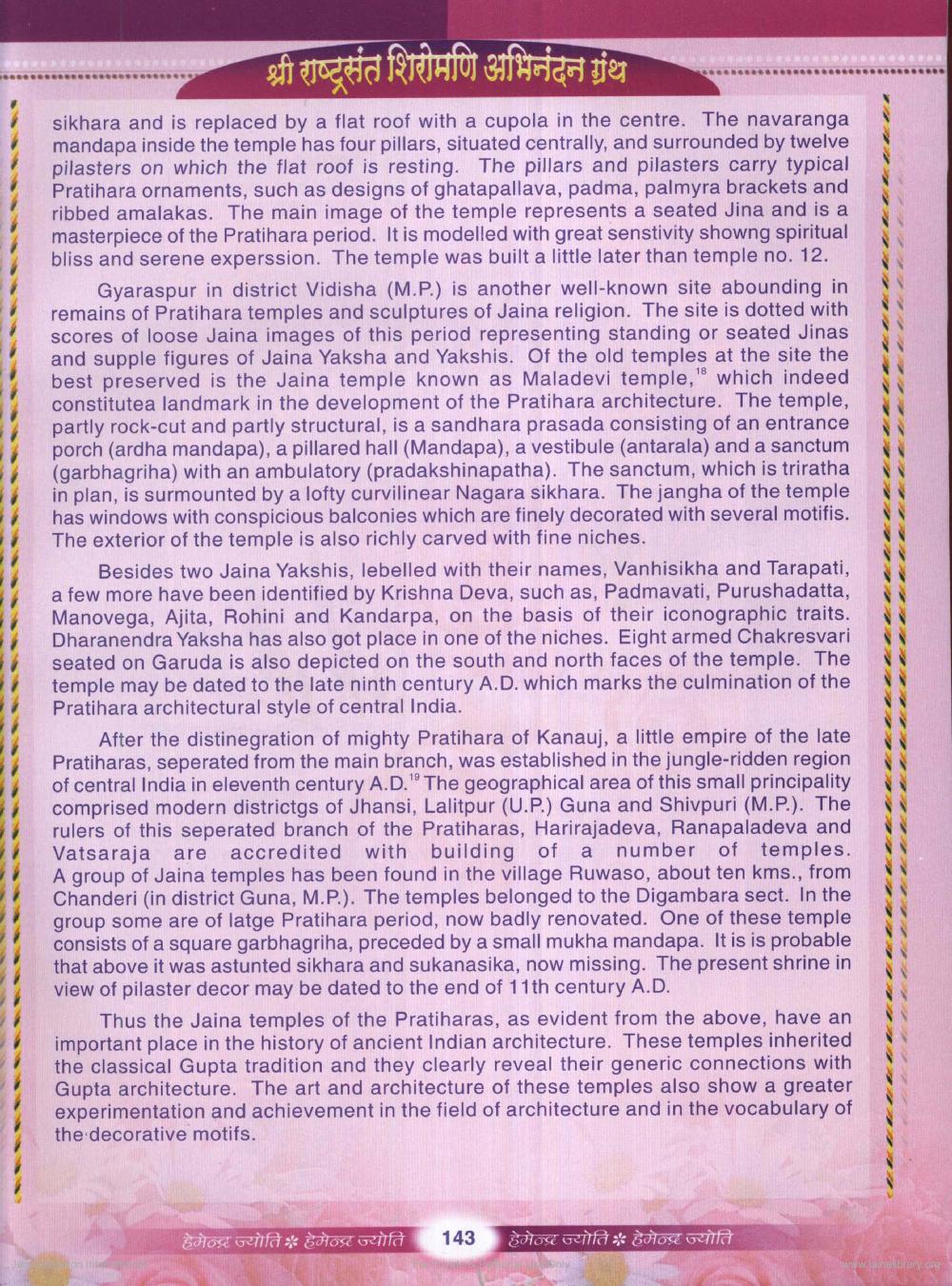________________
श्री राष्ट्रसंत शिरोमणि अभिनंदन ग्रंथ
sikhara and is replaced by a flat roof with a cupola in the centre. The navaranga mandapa inside the temple has four pillars, situated centrally, and surrounded by twelve pilasters on which the flat roof is resting. The pillars and pilasters carry typical Pratihara ornaments, such as designs of ghatapallava, padma, palmyra brackets and ribbed amalakas. The main image of the temple represents a seated Jina and is a masterpiece of the Pratihara period. It is modelled with great senstivity showng spiritual bliss and serene experssion. The temple was built a little later than temple no. 12.
Gyaraspur in district Vidisha (M.P.) is another well-known site abounding in remains of Pratihara temples and sculptures of Jaina religion. The site is dotted with scores of loose Jaina images of this period representing standing or seated Jinas and supple figures of Jaina Yaksha and Yakshis. Of the old temples at the site the best preserved is the Jaina temple known as Maladevi temple, which indeed constitutea landmark in the development of the Pratihara architecture. The temple, partly rock-cut and partly structural, is a sandhara prasada consisting of an entrance porch (ardha mandapa), a pillared hall (Mandapa), a vestibule (antarala) and a sanctum (garbhagriha) with an ambulatory (pradakshinapatha). The sanctum, which is triratha in plan, is surmounted by a lofty curvilinear Nagara sikhara. The jangha of the temple has windows with conspicious balconies which are finely decorated with several motifis. The exterior of the temple is also richly carved with fine niches.
Besides two Jaina Yakshis, lebelled with their names, Vanhisikha and Tarapati, a few more have been identified by Krishna Deva, such as, Padmavati, Purushadatta, Manovega, Ajita, Rohini and Kandarpa, on the basis of their iconographic traits. Dharanendra Yaksha has also got place in one of the niches. Eight armed Chakresvari seated on Garuda is also depicted on the south and north faces of the temple. The temple may be dated to the late ninth century A.D. which marks the culmination of the Pratihara architectural style of central India.
After the distinegration of mighty Pratihara of Kanauj, a little empire of the late Pratiharas, seperated from the main branch, was established in the jungle-ridden region of central India in eleventh century A.D. The geographical area of this small principality comprised modern districtgs of Jhansi, Lalitpur (U.P.) Guna and Shivpuri (M.P.). The rulers of this seperated branch of the Pratiharas, Harirajadeva, Ranapaladeva and Vatsaraja are accredited with building of a number of temples. A group of Jaina temples has been found in the village Ruwaso, about ten kms., from Chanderi (in district Guna, M.P.). The temples belonged to the Digambara sect. In the group some are of latge Pratihara period, now badly renovated. One of these temple consists of a square garbhagriha, preceded by a small mukha mandapa. It is is probable that above it was astunted sikhara and sukanasika, now missing. The present shrine in view of pilaster decor may be dated to the end of 11th century A.D.
Thus the Jaina temples of the Pratiharas, as evident from the above, have an important place in the history of ancient Indian architecture. These temples inherited the classical Gupta tradition and they clearly reveal their generic connections with Gupta architecture. The art and architecture of these temples also show a greater experimentation and achievement in the field of architecture and in the vocabulary of the decorative motifs.
हेमेन्द्र ज्योति* हेमेन्द्र ज्योति 143, हेमेन्द ज्योति * हेमेन्द्र ज्योति
library.com




